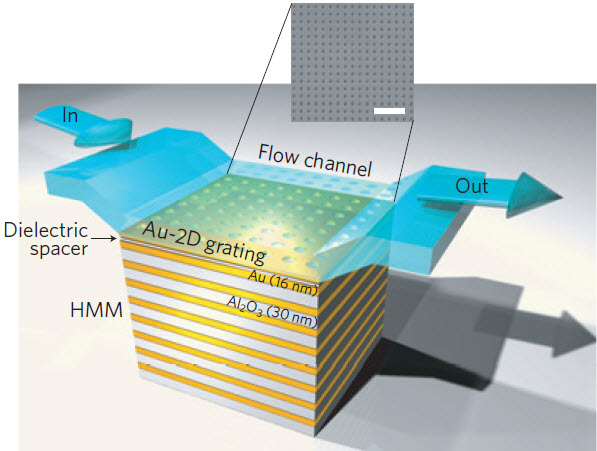
The research goal is to provide oncologists a way to detect a single molecule of an enzyme produced by circulating cancer cells. That could allow doctors to diagnose and monitor patients with certain cancers far earlier than possible today.
«The prognosis of many cancers depends on the stage of the cancer at diagnosis," said Giuseppe «Pino» Strangi, professor of physics at Case Western Reserve and research leader. «Very early, most circulating tumor cells express proteins of a very low molecular weight, less than 500 Daltons," Strangi explained. «These proteins are usually too small and in too low a concentration to detect with current test methods, yielding false negative results.
«With this platform, we’ve detected proteins of 244 Daltons, which should enable doctors to detect cancers earlier — we don’t know how much earlier yet," he said. «This biosensing platform may help to unlock the next era of initial cancer detection.»
The researchers believe the sensing technology will also be useful in diagnosing and monitoring other diseases.
A biological sieve
The nanosensor, which fits in the palm of a hand, acts like a biological sieve, capable of isolating a small protein molecule weighing less than 800 quadrillionths of a nanogram from an extremely dilute solution.
To make the device so sensitive, Strangi’s team faced two
The solution was to use a microfluidic channel to restrict the molecules’ ability to float around and a
«It’s extremely sensitive," Strangi said. «When a small molecule lands on the surface, it results in a large local modification, causing the light to shift." Depending on the size of the molecule, the reflecting light shifts different amounts. The researchers hope to learn to identify specific biomarker and other molecules for different cancers by their light shifts.
To add specificity to the sensor, the team added a layer of trap molecules — molecules that bind specifically with the molecules they hunt. In tests, the researchers used two trap molecules to catch two different biomolecules: bovine serum albumin, with a molecular weight of 66,430 Daltons, and biotin, with a molecular weight of 244 Daltons. Each produced a signature light shift.
Other researchers have reported using
Testing and clinical use in process
Strangi’s lab is working with other oncologists worldwide to test the device and begin moving the sensor toward clinical use.
In Cleveland, Strangi and Nima Sharifi, MD,
«For some cancers, such as colorectal and pancreatic cancer, early detection is essential," said Sharifi, who is also the Kendrick Family Chair for Prostate Cancer Research at Cleveland Clinic. «High sensitivity detection of
«This new sensing technology may help us not only detect cancers, but what subset of cancer, what’s driving its growth and spread, and what it’s sensitive to," he said. «The sensor, for example, may help us determine markers of aggressive prostate cancers, which require treatments, or indolent forms that don’t.»
The research is published online in the journal Nature Materials.
- The top gold layer is perforated with holes, creating a grating that diffuses light shone on the surface into two dimensions. The incoming light, which is several hundreds of nanometers in wavelength, appears to be confined and concentrated in a few nanometers at the interface between the gold and the dielectric layer. As the light strikes the sensing area, it excites free electrons causing them to oscillate and generate a highly confined propagating surface wave, called a surface plasmon polariton. This propagating surface wave will in turn excite a bulk wave propagating across the sensing platform. The presence of the waves cause deep sharp dips in the spectrum of reflecting light. The combination and the interplay of surface plasmon and bulk plasmon waves are what make the sensor so sensitive. Strangi said. By exciting these waves through the eight bilayers of the metamaterial, they create remarkably sharp resonant modes. Extremely sharp and sensitive resonances can be used to detect smaller objects.
Source:http://www.kurzweilai.net/a-biosensor-thats-1-million-times-more-sensitive


